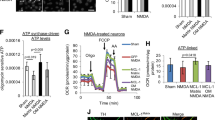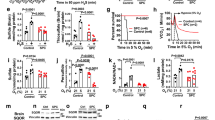Abstract
Whereas uncoupling protein 1 (UCP-1) is clearly involved in thermogenesis, the role of UCP-2 is less clear. Using hybridization, cloning techniques and cDNA array analysis to identify inducible neuroprotective genes, we found that neuronal survival correlates with increased expression of Ucp2. In mice overexpressing human UCP-2, brain damage was diminished after experimental stroke and traumatic brain injury, and neurological recovery was enhanced. In cultured cortical neurons, UCP-2 reduced cell death and inhibited caspase-3 activation induced by oxygen and glucose deprivation. Mild mitochondrial uncoupling by 2,4-dinitrophenol (DNP) reduced neuronal death, and UCP-2 activity was enhanced by palmitic acid in isolated mitochondria. Also in isolated mitochondria, UCP-2 shifted the release of reactive oxygen species from the mitochondrial matrix to the extramitochondrial space. We propose that UCP-2 is an inducible protein that is neuroprotective by activating cellular redox signaling or by inducing mild mitochondrial uncoupling that prevents the release of apoptogenic proteins.
This is a preview of subscription content, access via your institution
Access options
Subscribe to this journal
Receive 12 print issues and online access
$209.00 per year
only $17.42 per issue
Buy this article
- Purchase on Springer Link
- Instant access to full article PDF
Prices may be subject to local taxes which are calculated during checkout





Similar content being viewed by others
References
Kroemer, G. & Reed, J.C. Mitochondrial control of cell death. Nat. Med. 6, 513–519 (2000).
Dirnagl, U., Iadecola, C. & Moskowitz, M.A. Pathobiology of ischaemic stroke: an integrated view. Trends Neurosci. 22, 391–397 (1999).
Barone, F.C. et al. Ischemic preconditioning and brain tolerance: temporal histological and functional outcomes, protein synthesis requirement, and interleukin-1 receptor antagonist and early gene expression. Stroke 29, 1937–1950 (1998).
Negre-Salvayre, A. et al. A role for uncoupling protein-2 as a regulator of mitochondrial hydrogen peroxide generation. FASEB J. 11, 809–815 (1997).
Arsenijevic, D. et al. Disruption of the uncoupling protein-2 gene in mice reveals a role in immunity and reactive oxygen species production. Nat. Genet. 26, 435–439 (2000).
Brand, M.D. et al. Oxidative damage and phospholipid fatty acyl composition in skeletal muscle mitochondria from mice underexpressing or overexpressing uncoupling protein 3. Biochem. J. 368, 597–603 (2002).
Casteilla, L., Rigoulet, M. & Penicaud, L. Mitochondrial ROS metabolism: modulation by uncoupling proteins. IUBMB Life 52, 181–188 (2001).
Fleury, C. et al. Uncoupling protein-2: a novel gene linked to obesity and hyperinsulinemia. Nat. Genet. 15, 269–272 (1997).
Horvath, T.L. et al. Uncoupling proteins-2 and 3 influence obesity and inflammation in transgenic mice. Int. J. Obes. Relat. Metab. Disord. 27, 433–442 (2003).
Chan, C.B. et al. Increased uncoupling protein-2 levels in beta-cells are associated with impaired glucose-stimulated insulin secretion: mechanism of action. Diabetes 50, 1302–1310 (2001).
Li, L.X., Skorpen, F., Egeberg, K., Jorgensen, I.H. & Grill, V. Uncoupling protein-2 participates in cellular defense against oxidative stress in clonal beta-cells. Biochem. Biophys. Res. Commun. 282, 273–277 (2001).
Bechmann, I. et al. Brain mitochondrial uncoupling protein 2 (UCP2): a protective stress signal in neuronal injury. Biochem. Pharmacol. 64, 363–367 (2002).
Diatchenko, L. et al. Suppression subtractive hybridization: a method for generating differentially regulated or tissue-specific cDNA probes and libraries. Proc. Natl. Acad. Sci. USA 93, 6025–6030 (1996).
Krauss, S., Zhang, C.Y. & Lowell, B.B. A significant portion of mitochondrial proton leak in intact thymocytes depends on expression of UCP2. Proc. Natl. Acad. Sci. USA 99, 118–122 (2002).
Grabb, M.C. & Choi, D.W. Ischemic tolerance in murine cortical cell culture: critical role for NMDA receptors. J. Neurosci. 19, 1657–1662 (1999).
Gonzalez-Zulueta, M. et al. Requirement for nitric oxide activation of p21(ras)/extracellular regulated kinase in neuronal ischemic preconditioning. Proc. Natl. Acad. Sci. USA 97, 436–441 (2000).
Fuller, P.M., Warden, C.H., Barry, S.J. & Fuller, C.A. Effects of 2-G exposure on temperature regulation, circadian rhythms, and adiposity in UCP2/3 transgenic mice. J. Appl. Physiol. 89, 1491–1498 (2000).
Hara, H., Huang, P.L., Panahian, N., Fishman, M.C. & Moskowitz, M.A. Reduced brain edema and infarction volume in mice lacking the neuronal isoform of nitric oxide synthase after transient MCA occlusion. J. Cereb. Blood Flow Metab. 16, 605–611 (1996).
Smith, D.H. et al. A model of parasagittal controlled cortical impact in the mouse: cognitive and histopathologic effects. J. Neurotrauma 12, 169–178 (1995).
Scherbel, U. et al. Differential acute and chronic responses of tumor necrosis factor-deficient mice to experimental brain injury. Proc. Natl. Acad. Sci. USA 96, 8721–8726 (1999).
Castilho, R.F., Hansson, O., Ward, M.W., Budd, S.L. & Nicholls, D.G. Mitochondrial control of acute glutamate excitotoxicity in cultured cerebellar granule cells. J. Neurosci. 18, 10277–10286 (1998).
Wieloch, T. Mitochondrial involvement in acute neurodegeneration. IUBMB Life 52, 247–254 (2001).
Teranishi, M. et al. Swelling of free-radical-induced megamitochondria causes apoptosis. Exp. Mol. Pathol. 68, 104–123 (2000).
Anderson, M.F. & Sims, N.R. Improved recovery of highly enriched mitochondrial fractions from small brain tissue samples. Brain Res. Brain Res. Protoc. 5, 95–101 (2000).
Kowaltowski, A.J., Naia-da-Silva, E.S., Castilho, R.F. & Vercesi, A.E. Ca2+-stimulated mitochondrial reactive oxygen species generation and permeability transition are inhibited by dibucaine or Mg2+. Arch. Biochem. Biophys. 359, 77–81 (1998).
Bazan, N.G., Jr. Effects of ischemia and electroconvulsive shock on free fatty acid pool in the brain. Biochim. Biophys. Acta 218, 1–10 (1970).
Fink, B.D. et al. UCP2-dependent proton leak in isolated mammalian mitochondria. J. Biol. Chem. 277, 3918–3925 (2002).
Echtay, K.S. et al. Superoxide activates mitochondrial uncoupling proteins. Nature 415, 96–99 (2002).
Harper, J.A., Dickinson, K. & Brand, M.D. Mitochondrial uncoupling as a target for drug development for the treatment of obesity. Obes. Rev. 2, 255–265 (2001).
Jarmuszkiewicz, W., Behrendt, M., Navet, R. & Sluse, F.E. Uncoupling protein and alternative oxidase of Dictyostelium discoideum: occurrence, properties and protein expression during vegetative life and starvation-induced early development. FEBS Lett. 532, 459–464 (2002).
Korshunov, S.S., Korkina, O.V., Ruuge, E.K., Skulachev, V.P. & Starkov, A.A. Fatty acids as natural uncouplers preventing generation of O2 and H2O2 by mitochondria in the resting state. FEBS Lett. 435, 215–218 (1998).
Liu, S.S. Generating, partitioning, targeting and functioning of superoxide in mitochondria. Biosci. Rep. 17, 259–272 (1997).
Castilho, R.F., Kowaltowski, A.J., Meinicke, A.R., Bechara, E.J. & Vercesi, A.E. Permeabilization of the inner mitochondrial membrane by Ca2+ ions is stimulated by t-butyl hydroperoxide and mediated by reactive oxygen species generated by mitochondria. Free Radic. Biol. Med. 18, 479–486 (1995).
Halestrap, A.P., Kerr, P.M., Javadov, S. & Woodfield, K.Y. Elucidating the molecular mechanism of the permeability transition pore and its role in reperfusion injury of the heart. Biochim. Biophys. Acta 1366, 79–94 (1998).
Fiskum, G. Mitochondrial participation in ischemic and traumatic neural cell death. J. Neurotrauma 17, 843–855 (2000).
Nowicki, J.P., Assumel-Lurdin, C., Duverger, D. & MacKenzie, E.T. Temporal evolution of regional energy metabolism following focal cerebral ischemia in the rat. J. Cereb. Blood Flow. Metab. 8, 462–473 (1988).
Echtay, K.S., Winkler, E. & Klingenberg, M. Coenzyme Q is an obligatory cofactor for uncoupling protein function. Nature 408, 609–613 (2000).
Hampton, M.B., Fadeel, B. & Orrenius, S. Redox regulation of the caspases during apoptosis. Ann. NY Acad. Sci. 854, 328–335 (1998).
Susin, S.A. et al. Molecular characterization of mitochondrial apoptosis-inducing factor. Nature 397, 441–446 (1999).
Mattson, M.P., Culmsee, C. & Yu, Z.F. Apoptotic and antiapoptotic mechanisms in stroke. Cell Tissue Res. 301, 173–187 (2000).
Kato, H. et al. Immunohistochemical localization of superoxide dismutase in the hippocampus following ischemia in a gerbil model of ischemic tolerance. J. Cereb. Blood Flow Metab. 15, 60–70 (1995).
Couplan, E. et al. No evidence for a basal, retinoic, or superoxide-induced uncoupling activity of the uncoupling protein 2 present in spleen or lung mitochondria. J. Biol. Chem. 277, 26268–26275 (2002).
Shamloo, M. & Wieloch, T. Changes in protein tyrosine phosphorylation in the rat brain after cerebral ischemia in a model of ischemic tolerance. J. Cereb. Blood Flow Metab. 19, 173–183 (1999).
Kuroda, S., Tsuchidate, R., Smith, M.L., Maples, K.R. & Siesjo, B.K. Neuroprotective effects of a novel nitrone, NXY-059, after transient focal cerebral ischemia in the rat. J. Cereb. Blood Flow Metab. 19, 778–787 (1999).
Bentzer, P., Mattiasson, G., McIntosh, T.K., Wieloch, T. & Grande, P.O. Infusion of prostacyclin following experimental brain injury in the rat reduces cortical lesion volume. J. Neurotrauma 18, 275–285 (2001).
Xiong, Y., Gu, Q., Peterson, P.L., Muizelaar, J.P. & Lee, C.P. Mitochondrial dysfunction and calcium perturbation induced by traumatic brain injury. J. Neurotrauma 14, 23–34 (1997).
Sims, N.R. Rapid isolation of metabolically active mitochondria from rat brain and subregions using Percoll density gradient centrifugation. J. Neurochem. 55, 698–707 (1990).
Arnaiz, S.L., Coronel, M.F. & Boveris, A. Nitric oxide, superoxide, and hydrogen peroxide production in brain mitochondria after haloperidol treatment. Nitric Oxide 3, 235–243 (1999).
Acknowledgements
We thank K. Beirup, S. Barry and S. Bennett for expert technical assistance. This work was supported by the Swedish Science Council (Project No. 08644), a grant from AGY Therapeutics, the Swedish National Network in Neuroscience, Fundação de Amparo a Pesquisa do Estado de São Paulo, Brazil, the Swedish Association of Neurologically Disabled, The Mattson foundation, the Royal Physiographic Society and National Institutes of Health grant RO1 DK53993.
Author information
Authors and Affiliations
Corresponding author
Ethics declarations
Competing interests
This work was supported by a grant from AGY Therapeutics. AGY Therapeutics has filed a patent on the use of UCP-2 as a neuroprotectant.
Rights and permissions
About this article
Cite this article
Mattiasson, G., Shamloo, M., Gido, G. et al. Uncoupling protein-2 prevents neuronal death and diminishes brain dysfunction after stroke and brain trauma. Nat Med 9, 1062–1068 (2003). https://doi.org/10.1038/nm903
Received:
Accepted:
Published:
Issue Date:
DOI: https://doi.org/10.1038/nm903
This article is cited by
-
Ischemia and reperfusion injury combined with cisplatin induces immunogenic cell death in lung cancer cells
Cell Death & Disease (2022)
-
The study of neuroprotective effects and underlying mechanism of Naoshuantong capsule on ischemia stroke mice
Chinese Medicine (2020)
-
A Ketogenic Diet Improves Mitochondrial Biogenesis and Bioenergetics via the PGC1α-SIRT3-UCP2 Axis
Neurochemical Research (2019)
-
Effect of Initial Aging and High-Fat/High-Fructose Diet on Mitochondrial Bioenergetics and Oxidative Status in Rat Brain
Molecular Neurobiology (2019)
-
Uncoupling Protein 2 Inhibition Exacerbates Glucose Fluctuation-Mediated Neuronal Effects
Neurotoxicity Research (2018)



